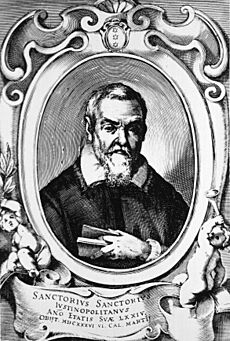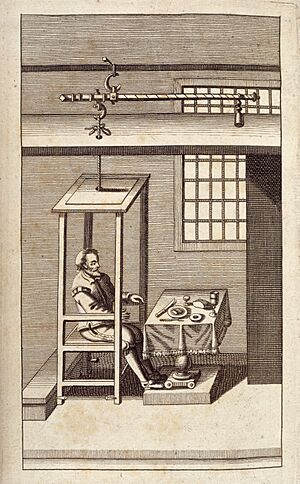Santorio Santorio facts for kids
Quick facts for kids
Santorio Santorio
|
|
|---|---|
 |
|
| Born | 29 March 1561 |
| Died | 25 February 1636 (aged 74) Venice, Republic of Venice
|
| Alma mater | University of Padua |
| Known for | Discoveries concerning metabolism and invention of technical instruments |
Santorio Santorio (born March 29, 1561 – died February 25, 1636), also known as Sanctorius of Padua, was an Italian doctor and professor. He was very important because he brought a new way of thinking to science. He started using measurements and experiments in the study of the human body. Because of this, he is often called the "father of experimental physiology."
Santorio also invented many useful medical tools. His book, De Statica Medicina, published in 1614, was very popular. It taught doctors for many years after it was written.
Contents
Life of Santorio Santorio
Santorio was born on March 29, 1561. His hometown was Capodistria, which was part of Venice at the time. Today, this place is in Slovenia. His mother, Elisabetta Cordoni, came from a noble family. His father, Antonio, was also a nobleman. He worked for the Venetian government.
Santorio studied in his hometown first. Then he moved to Venice for more education. In 1578, he joined the University of Padua. He finished his medical degree there in 1585. After graduating, he worked as a personal doctor for a nobleman in Croatia. This was from 1587 to 1594. Later, he opened his own medical office in Venice. There, he met the famous scientist Galileo.
Santorio passed away in Venice on February 25, 1636. He had been sick for many years. He was buried in a church called Santa Maria dei Servi. He had worked as a doctor for the people at that church for a long time.
Santorio's Work and Discoveries
From 1611 to 1624, Santorio was a professor at the University of Padua. He taught about theoretical medicine. During this time, he did some of the first experiments on the human body. He studied body temperature, how much a person sweats without noticing (called "insensible perspiration"), and body weight.
In 1624, he left the university. He went back to being a doctor in Venice in 1625. In 1630, he was part of a group of doctors. They were chosen to help people during the Venetian plague.
Santorio is famous in science because he helped develop experimental methods. He created special tools to measure the body's balance. These tools helped him check things like pulse, temperature, and insensible perspiration. He used instruments called pulsilogia for pulse. He used hydrolabiaSanctorii for temperature. He also used a special weighing chair, known as sella Sanctorii. This chair is still linked to his name today.
Amazing Inventions
Santorio was a true inventor. He was the first to use a wind gauge to measure wind speed. He also created a water current meter. This tool measured how fast water moved.
One of his most important medical tools was the pulsilogium. This device measured a person's pulse rate. He also invented a thermoscope, which was an early version of a thermometer. Santorio introduced his pulsilogium in 1602. He brought out his thermoscope in 1611. These inventions came before similar ones by his friends, like Galileo Galilei.
The pulsilogium was likely the first very precise machine in medical history. Santorio used it a lot to experiment. This helped him understand the pulse better. He could describe different pulse rates, both regular and irregular. Many years later, another doctor used the pulsilogium. He used it to check how well the heart was working.
Studying the Body's Changes
Santorio spent a lot of time studying something called perspiratio insensibilis. This means "insensible perspiration," or sweating that you don't feel. Ancient doctors like Galen knew about this. Santorio's work started the study of metabolism. Metabolism is how your body uses food and creates energy.
For 30 years, Santorio used a special chair. This chair was connected to a scale. He would weigh himself, everything he ate and drank, and his waste products. He found that the weight of his waste was much less than the food he ate. For every eight pounds of food, he only got rid of about three pounds of waste. This showed that a lot of weight was lost through insensible perspiration. Santorio also used his weighing chair to study his patients.
His main finding from these experiments was very important. He realized that insensible perspiration happens in two ways. First, through tiny holes in the skin, like a net. Second, through breathing out of the mouth. He found that breathing out could account for about half a pound of weight loss each day. You can see this by breathing on a glass.
This experiment was a big step for medicine. It showed how important it is to measure weight. Even though other scientists later improved on his work, Santorio is still known as the "father of experimental physiology." His famous "weighing chair" is a symbol of his groundbreaking research.
Awards Honoring Santorio
In January 2018, an Italian group created a special center. It's called the Centre for the Study of Medicine and the Body in the Renaissance (CSMBR). This center honors Santorio. It is a place for advanced research in medical history.
The center gives out several awards and grants each year. These are named after Santorio. They include the Santorio Award for Excellence in Research. There's also the Santorio Fellowship for Medical Humanities and Science. And the Santorio Global Fellowship helps scholars from all over the world.


